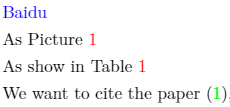catalogue
reference
Macro packages used for reference typesetting and citation include:
\usepackage{cite}
\usepackage[number, sort&compress]{natbib}1. Direct insertion method
1.1 insert literature
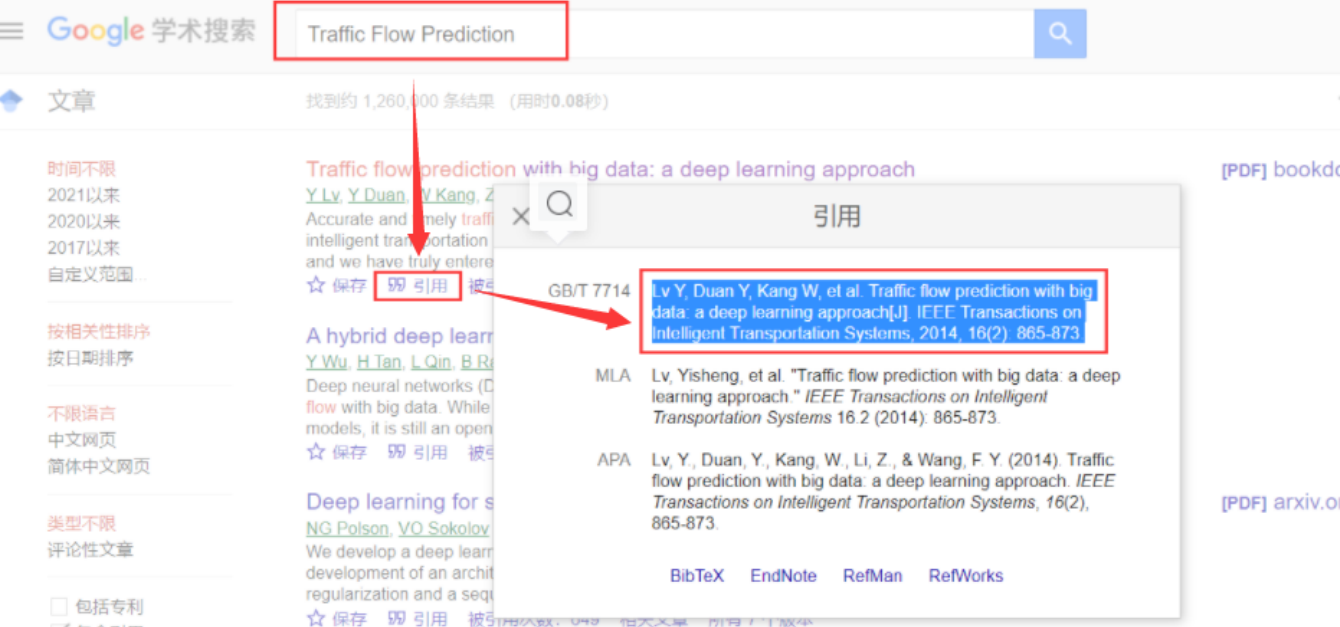
Find the references to be inserted and list them one by one.
Five references are listed below. The option 100 of {thebibliography}[100] indicates that the maximum number of references is 100\ bibitem{label} represents a reference, and the label represents the annotation of the document, that is, it will be used in the quotation of the text.
\begin{thebibliography}{100}
\bibitem{ref1}Lv Y, Duan Y, Kang W, et al. Traffic flow prediction with big data: a deep learning approach[J]. IEEE Transactions on Intelligent Transportation Systems, 2014, 16(2): 865-873.
\bibitem{ref2}Wu Y, Tan H, Qin L, et al. A hybrid deep learning based traffic flow prediction method and its understanding[J]. Transportation Research Part C: Emerging Technologies, 2018, 90: 166-180.
\bibitem{ref3}Polson N G, Sokolov V O. Deep learning for short-term traffic flow prediction[J]. Transportation Research Part C: Emerging Technologies, 2017, 79: 1-17.
\bibitem{ref4}Yin H, Wong S C, Xu J, et al. Urban traffic flow prediction using a fuzzy-neural approach[J]. Transportation Research Part C: Emerging Technologies, 2002, 10(2): 85-98.
\bibitem{ref5}Fu R, Zhang Z, Li L. Using LSTM and GRU neural network methods for traffic flow prediction[C]//2016 31st Youth Academic Annual Conference of Chinese Association of Automation (YAC). IEEE, 2016: 324-328.
\end{thebibliography}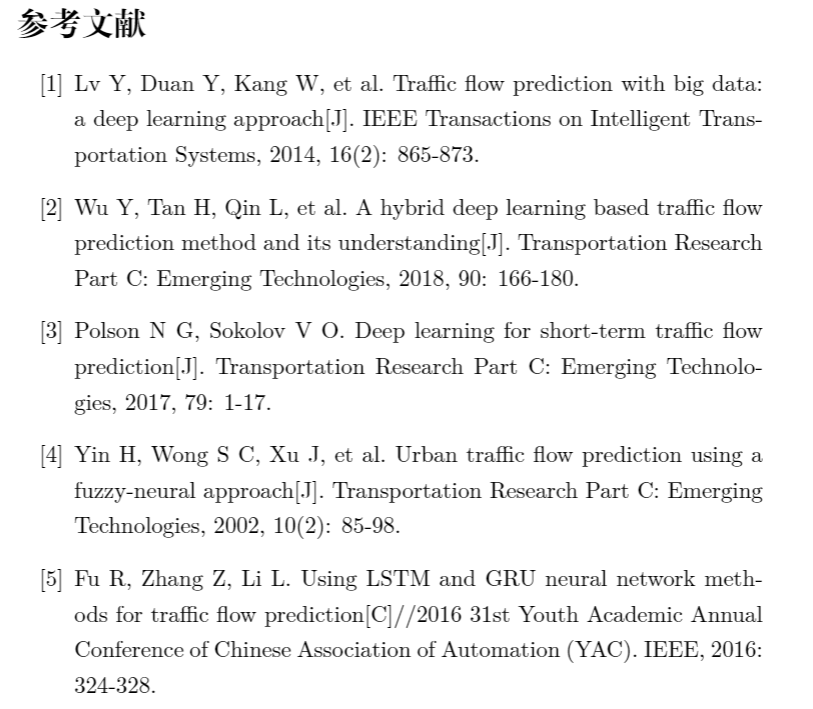
1.2 references
\usepackage{cite}: the macro package needed to quote references
For references, use the command \ cite
1.2.1 single document citation
We want to cite the paper \cite{ref1}
1.2.2 multiple references
We want to cite the paper \cite{ref1,ref2,ref5} \par
We want to cite the paper \cite{ref1,ref2,ref3}
2. BibTex method
BibTeX is a format and a program used to coordinate the reference processing of LaTeX. BibTeX uses a database to manage references. Under the file directory where the current. tex file is located, create a format file with. Bib as the suffix, named lookup.bib
2.1 thesis
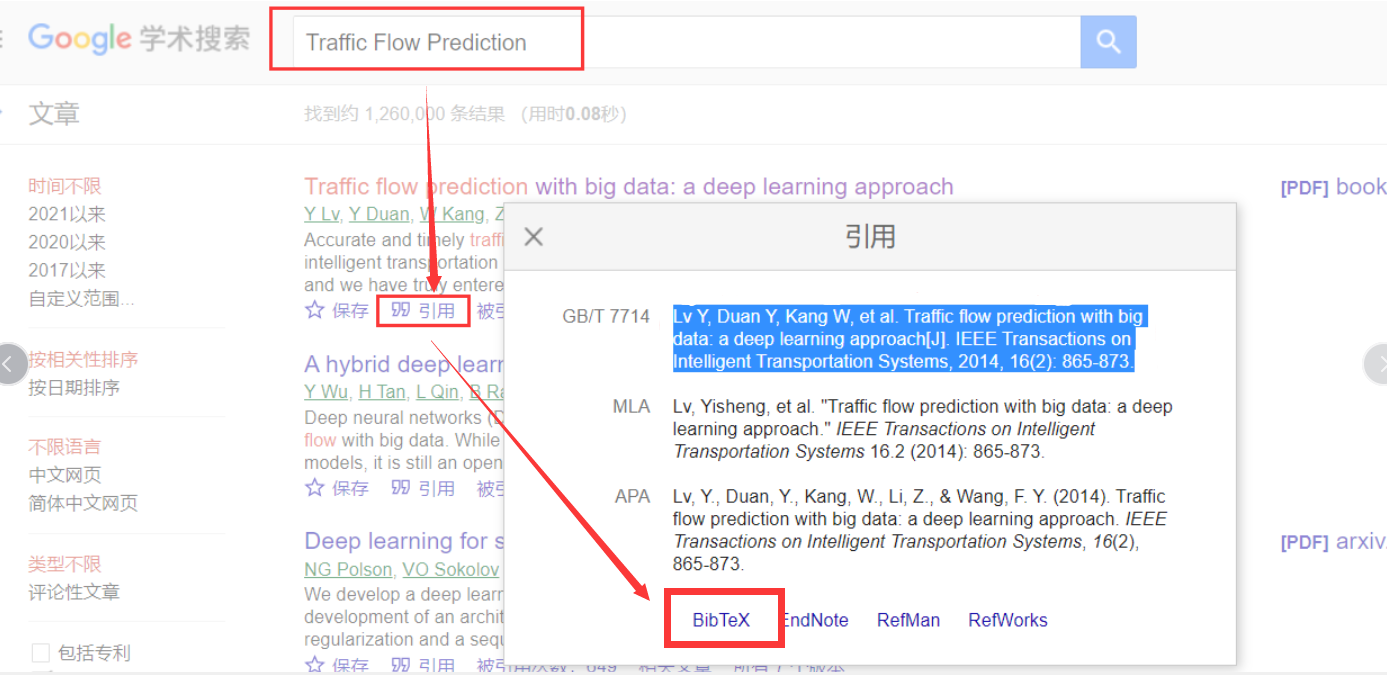
Take the following literature as an example.
@article{2015Traffic,
title={Traffic Flow Prediction With Big Data: A Deep Learning Approach},
author={ Lv, Y. and Duan, Y. and Kang, W. and Li, Z. and Wang, F. Y. },
journal={IEEE Transactions on Intelligent Transportation Systems},
volume={16},
number={2},
pages={865-873},
year={2015},
}-
label
@article{2015Traffic,
}Among them, 2015Traffic is a label used for references in the text. The label can be changed as long as it does not duplicate other references in this paper.
-
Literature parameters
title: Thesis title, author: Paper author, journal: Papers are published in journals, conferences or affiliated, and some papers are used booktitle, volume: volume, number: number, pages: Page number, year: particular year
Some papers may not be so complete, so we need to find relevant information and fill it in by ourselves.
In the following example, we added BibTex of five literatures to the lookup.bib file:
@article{2015Traffic,
title={Traffic Flow Prediction With Big Data: A Deep Learning Approach},
author={ Lv, Y. and Duan, Y. and Kang, W. and Li, Z. and Wang, F. Y. },
journal={IEEE Transactions on Intelligent Transportation Systems},
volume={16},
number={2},
pages={865-873},
year={2015},
}
@inproceedings{2017Traffic,
title={Traffic Flow Prediction with Big Data: A Deep Learning based Time Series Model},
author={ Chen, Y. and Lei, S. and Lei, W. },
booktitle={IEEE INFOCOM 2017 -IEEE Conference on Computer Communications Workshops (INFOCOM WKSHPS)},
year={2017},
}
@article{2019Big,
title={Big data‐driven machine learning‐enabled traffic flow prediction},
author={ Fanhui, Kong and Jian, Li and Bin, Jiang and Tianyuan, Zhang and Houbing, Song },
journal={Transactions on Emerging Telecommunications Technologies},
volume={30},
pages={e3482-},
year={2019},
}
@article{2019Deep,
title={Deep Transfer Learning for Intelligent Cellular Traffic Prediction Based on Cross-Domain Big Data},
author={ Zhang, C. and Zhang, H. and Qiao, J. and Yuan, D. and Zhang, M. },
journal={IEEE Journal on Selected Areas in Communications},
pages={1-1},
year={2019},
}
@article{Hong2014Deep,
title={Deep Architecture for Traffic Flow Prediction: Deep Belief Networks With Multitask Learning},
author={Hong and H. and Xie and K. and Huang and W. and Song and G.},
journal={IEEE transactions on intelligent transportation systems},
volume={15},
number={5},
pages={2191-2201},
year={2014},
}main.tex body:
\section{REFERENCES}
\subsection{An overview of references}
We want to cite the paper \cite{2015Traffic}, \par
We want to cite the paper \cite{2015Traffic,2017Traffic, 2019Big}, \par
We want to cite the paper \cite{2015Traffic,2019Big,Hong2014Deep}, \par
\bibliographystyle{ieeetr}
\bibliography{lookup} 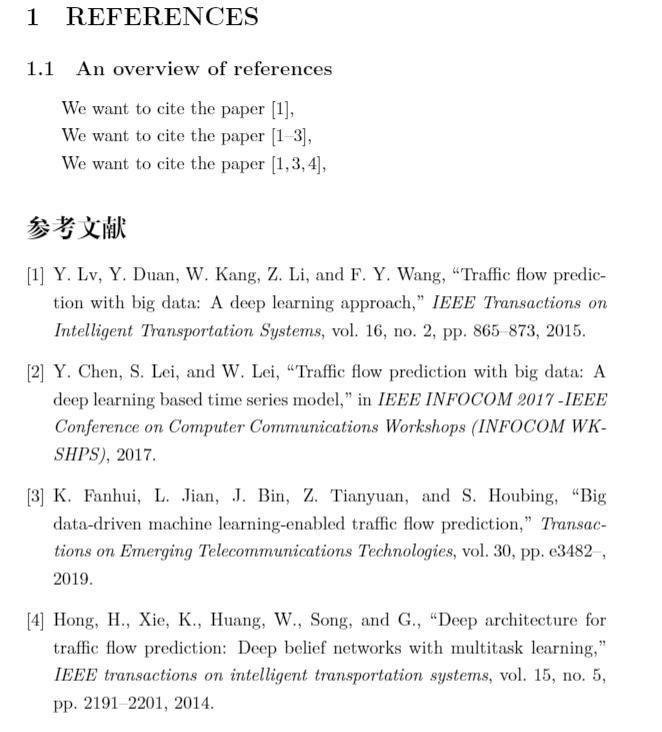
From the results, we can see that we have added five references in the lookup.bib file, but there are only four in the References section of the article. The reason is: BibTex method typesetting literature. If a paper is not quoted in the body, even if it is in the. Bib file, the references will not be displayed.
\bibliographystyle {...} is the style of inserting references. Different magazines and periodicals have different styles. There are 8 options for common preset styles, namely:
-
plain: in alphabetical order, the comparison order is author, year and title;
-
unsrt: the style is the same as plain, but it is sorted according to the order of references;
-
Abrv: similar to plain, the full spelling of month is changed to abbreviation, which is more compact;
-
IEEE tr: journal style of International Association of electrical and electronic engineers;
-
acm: journal style of American computer society;
-
siam: journal style of American Society of industrial and applied mathematics;
2.2 web pages
The final style of references on the web page is:
[1] author. Page name. (time). [Online]. Available: Web link (URL)
Web page reference needs to involve five parts: tag, author, title, link and time. Tags, titles and links are essential.
@online{label,
author="Author name",
title="{Page name}",
url="Web link",
note="(year, Month day)",
}online means that the document is a web page, and the most important format is time (2021, Jun 1):
-
Arabic numerals shall be used for the year, and commas shall be added after the year;
-
The first three letters of the month should be capitalized.
-
The day should be in Arabic numerals and there should be a space between the day and the month.
Add the following web page content to the lookup.bib file and reference it in the main.tex file (because it can be displayed in the references).
@online{PBClibrary,
author="Ben Lynn",
title="{The Pairing-Based Cryptography (PBC) library}",
url="https://crypto.stanford.edu/pbc/",
note="(2013, Jun 14)",
}
3. Change reference color
Before changing the reference color, it is best to import the xcolor macro package in the introduction area with the code \ usepackage{xcolor}. To change the reference color, you need to add the following code in the introduction area:
\usepackage[colorlinks,bookmarksopen,bookmarksnumbered,citecolor=green, linkcolor=red, urlcolor=blue]{hyperref}citecolor is the color of references, linkcolor is the color of charts and formulas, and urlcolor is the color of hyperlinks. Each color can be changed according to preference or requirements.
\href{http://www.baidu.com}{Baidu} % Hyperlinks
As Picture \ref{pic1} %picture
As show in Table \ref{table1} %form
We want to cite the paper \cite{2015Traffic} %literature